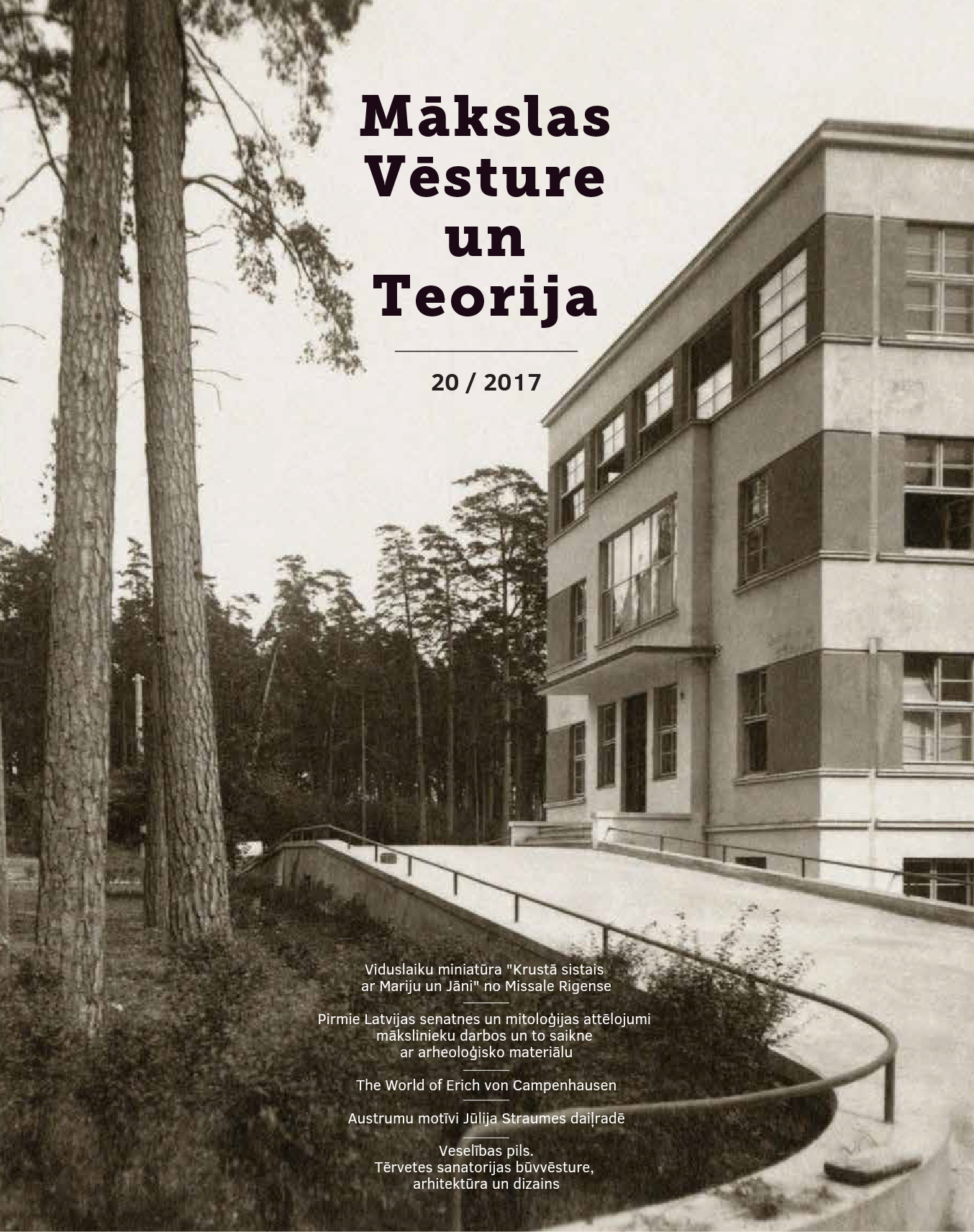The World of Erich von Campenhausen: A Creative Spirit to Mark the Opening of a New Artistic Era in Riga… and Beyond (Art Historical Lacunae: A Case Study)
The World of Erich von Campenhausen: A Creative Spirit to Mark the Opening of a New Artistic Era in Riga… and Beyond (Art Historical Lacunae: A Case Study)
Author(s): Jeremy HowardSubject(s): Cultural history, Visual Arts, Local History / Microhistory, Pre-WW I & WW I (1900 -1919)
Published by: Mākslas vēstures pētījumu atbalsta fonds
Keywords: ERICH VON CAMPENHAUSEN; BALTIC GERMAN ART; ART NOUVEAU; APPLIED ART; FURNITURE DESIGN; POSTER DESIGN
Summary/Abstract: The article deals with the diverse activities of the Baltic German artist Erich von Campenhausen (1872–1926) and analysis of his known works in the art-historical context. As Campenhausen’s output did not fit into the narrative of national art history, it continues to challenge scholars as a ‘blank spot’ yet to be filled. In his early period after returning to Riga from Karlsruhe where he studied engineering, the artist was more involved with applied arts while later he studied at the Karlsruhe Academy of Art (1909–1914) and took up painting and graphics to a greater extent. The so-called ‘play’ figures (Scherzfiguren) created around 1907 were ceramic sculptures of exotic animals, with their rounded forms reminding of Japanese netsuke. About the same time Campenhausen also made 18 “humorous art postcards”, coloured ink drawings, showing “joys and sufferings of a Negro boy”, according to the press of the time. Campehausen’s contribution to applied arts is represented in the Baltic art yearbook Bildende Kunst der Ostseeprovinzen in 1907. The suite of living room furniture stands out by harmonic simplicity, careful horizontal-vertical balance and utilitarian qualities suggestive of contemporary modern German and Austrian furniture design. Square-form cushion is decorated with amorphous patterns of lines and colours whose abstract flow has much in common with the organic trend of Art Nouveau. Also a belt buckle image was published with geometricised leaf ornament. Journey towards abstraction is even clearer in Campenhausen’s design of six plates with rims adorned by repetitive motifs of birds and buds, reminiscent of Charles Rennie Mackintosh and Henry van de Velde. Subsequent issues of the same yearbook (1908–1909) also popularised Campenhausen’s dinner service, silver cutlery and furniture design examples – modern, functional and lightly decorated. Campehnausen designed a fireplace too, decorated with flame-like, budding forms (the dark blue majolica tiles were produced at Zelm & Boehm factory; the object has survived in Puikule Manor). In all, Campehausen’s approach was based on laconic aesthetics, envisioning beauty in simplicity that sharply differs from his younger brother Balthasar von Campenhausen’s output illustrated in later issues of the yearbook (1911–1912). These are rather Historicist interiors with Baroque forms and decorative weightiness of patterned, upholstered furniture and tapestries. Rational, geometrical approach similar to Erich von Campenhausen’s can be seen in the architect Max Deubner’s children’s room in the apartment of Paul Kerkovius (1912). Also Jūlijs Madernieks’ subdued aestheticism and predominantly rectilinear style that replaced his earlier ornate, curvilinear forms and is evident in his own Riga apartment, is close to Campehausen. Erich von Campenhausen also took part in the poster competition (1907–1908) organised by Rigascher Kunstverein (Riga Art Society) to find the best solution to advertise society’s exhibitions in the recently opened Riga City Art Museum. Among the participants were Aleksandrs Romans, Alfrēds Purics, Bernhard Borchert and other artists. Posters had to include the text Rigascher Kunstverein as well as ‘art exhibition’ in German, Latvian and Russian. Three submissions (Romans’, Purics’ and Campenhausen’s) were published in the aforementioned Baltic art yearbook (1908). The competition itself signalled certain integration of German and Latvian cultural spaces in the complex post-revolutionary atmosphere; participants as well as those selected for publication represented both factions. The first prize went to Romans’ poster with the codeword Del Sarto; it was clearly derived from the Florentine painter Andrea del Sarto’s portrait of the sculptor Baccio Bandinelli (1515–1517), as evident from the facial features, clothing details and haircut. In Romans’ interpretation, the image is flattened and sharpened, giving up spatial illusion but the added figurine can be interpreted as the symbol of art. Purics’ poster with the codeword Cross in Circle is more visually baffling and in line with the Symbolist tradition and its searches for the meaning of life. Campenhausen’s poster with the codeword Grove is no less mysterious, the chosen sans serif script being less readable from a greater distance. The image of the sacred grove appears as the cradle of mystic spirituality important for National Romanticism. The poster can be perceived as a modernised interpretation of Arnold Böcklin’s work Sacred Grove (1882) in the vein of Art Nouveau, comparable also to decorative solutions of Gustav Klimt. Fifteen years later, Campenhausen created another poster, announcing the lottery of the German Baltic Charitable Institution (1923) and depicting a fashionable young woman with a cornucopia. This poster can be seen in a dialectic opposition to Sigismunds Vidbergs’ poster for the ‘Voice of Culture’ lottery raising funds for mobile libraries (1921–1922). Its male incarnation of Latvian socialists is more vigorous and forward thrusting than the evanescent, feminised embodiment of Baltic German charity; at the same time, they are also partners typifying the difficult period of the early 1920s.
Journal: Mākslas Vēsture un Teorija
- Issue Year: 2017
- Issue No: 20
- Page Range: 36-55
- Page Count: 20
- Language: English
- Content File-PDF

